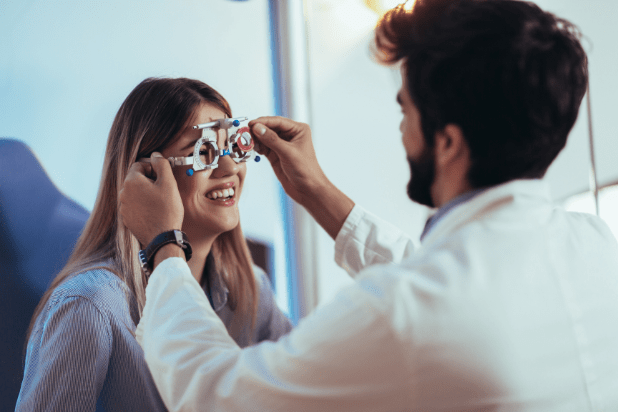What is a diopter? Fully Explained

A diopter is a unit of measurement used in eye care to quantify the focusing power of a lens. The word diopter is thought to be derived from the Greek word dioptra, an optical instrument used for measuring angles or altitudes, which is thought to have been invented by the Greek astronomer Hipparchus in 150 BC.
In the mid-1800s, Ophthalmologists Ferdinand Monoyer and Albrecht Nagel changed the meaning of the word diopter from a device to its current meaning as the unit for the refractive power of a lens.
Diopters are used in glasses and contact lens prescriptions to measure vision correction. The diopter value indicates the strength of the lens required to correct vision. A lens with a higher diopter value has greater power and can bend light more. Diopters and specific instruments, including telescopes and binoculars, are also used in photography.
Thorough Understanding of the Concept of Diopters
The optical concept of refraction occurs when light passes through a lens and either converges or diverges. The amount of light that is bent is determined by the diopter value of the lens. A convex or plus lens causes light to converge, but a concave or negative lens causes light rays to spread out. This information is used to correct one’s vision.
Role of Diopters in Vision Correction
A refraction is part of the eye exam where your doctor determines your eyeglass prescription. The doctor will measure your refractive error (myopia, hyperopia, astigmatism, presbyopia) regarding diopters. You will be asked a series of choices (one or two), and your selection determines your eyeglass prescription. The dioptric value measures the strength of the lenses needed to correct your vision by bringing objects into focus on the retina.
If your prescription has a positive diopter value, the lens converges light rays and corrects your farsightedness (hyperopia). A negative diopter value indicates the lens diverges light and will correct for nearsightedness (myopia). Negative diopter values shift the focal point backward onto the retina, while positive values move the focal point forward onto the retina.
Glasses and/or contact prescriptions ranging from +2.00D to -2.00D are considered mild. Prescriptions ranging from +4.00D to +2.00D or –2.00D to -4.00D are considered moderate, and prescriptions outside of these ranges are considered high. Often, there is a slight difference between the dioptric value of your glasses and contact lens prescription as a contact sits on your eyes, and eyeglasses sit around 12 mm from your eyes.
Presbyopia is a condition that occurs in patients over the age of 40. Changes to the ciliary muscle and lens inside the eye cause us to lose our ability to focus up close. The diopter power of your near vision is always a positive number (+) and will gradually increase from +1.00D to +2.50D. Over-the-counter reading glasses, sometimes called cheaters, are available in a wide range of plus-diopter lenses.
The relationship between diopters and meters
One diopter (D) is equivalent to the reciprocal of the lens's focal length in meters. A lens with a power of 1 diopter (1D) indicates that light rays passing through it will either converge or diverge from a point one meter away. For example, a +2.00-diopter lens has a focal length of 0.5 meters, meaning it converges light to focus at a distance of one-half meter; whereas a -3.00 diopter lens has a focal length of -0.33 meters and diverges light at one-third meter.
Factors Affecting Diopter Measurement
Several factors influence the measurement of diopters, including:
- Ocular Anatomy: The physical characteristics of an individual's eye, like the cornea's curvature and the eyeball's length, affect how light rays converge or diverge onto the retina. A long eye results in myopia, a short eye leads to hyperopia,, and an abnormal cornea and/or lens shape results in astigmatism.
- Doctors Refraction: A refraction is used by a doctor to determine a patient’s prescription using the patient’s subjective responses. The patient indicates which lenses provide the clearest vision by answering which lens choice is better. A doctor’s experience is helpful in interpreting their responses.
- Optical Instruments: The accuracy and precision of the optical instruments used to determine refraction, such as the phoropter and autorefractor, are important.
- Patient Cooperation: The refraction depends on the patient’s ability to focus and respond accurately. Eye fatigue and a patient’s focus can affect the test’s results. For this reason, doctors may prefer to see children earlier in the day.
How Diopters Are Measured
Diopters are measured using a test called refraction. The eye doctor evaluates how light is refracted by the eye’s optical system to determine the presence of refractive errors, including myopia, hyperopia, astigmatism, and/or presbyopia. Lenses are then prescribed to correct the refractive errors.
Each lens in the phoropter has a diopter value, and the doctor adjusts the lenses until the patient achieves the best vision at 20 feet in the distance and at 40 cm up close. The cylindrical power is used to correct the irregular curvature of the cornea or lens (astigmatism) and is also measured in diopters. The doctor will prescribe a standard notation indicating the sphere, cylinder, axis, and, if needed, a near add for reading.
What is a diopter chart?
Eye doctors often use a Snellen chart to measure a patient’s visual acuity and prescribe corrective lenses. The Snellen chart usually shows rows of capital letters with a very large letter on the first row, “E,” and each row after that has smaller letters. The patient is asked to read the rows of letters 20 feet away. The information attained from a Snellen chart can be converted to diopters. An actual diopter chart is more likely found in a store selling reading glasses. The chart indicates what diopter power of readers you should buy if you need to see a particular size font. Keep in mind that smaller fonts will require increased diagonal lens power.
How Diopters Affect Lens Choices
The dioptric value of your lenses should be used to guide your lens choices. If your diopter value is low, your lenses can be made from CR-39 or Trivex. If your value is more moderate, consider having your lenses made from polycarb if you desire lighter, thinner lenses. For high diopter values, lenses should be made from high-index material. Overnight Glasses offers more information on lens materials based on your prescription.
Tips for Maintaining Healthy Diopter Levels
Both environmental and genetic factors affect the dioptric level of your prescription. Preventing your prescription from worsening can only be achieved during childhood by utilizing a type of therapy called myopia control. There are many ways to maintain good eye health during adulthood, including:
- Routine Eye Exams: You should see your doctor annually to assess your vision, monitor the dioptric value of your prescription, and determine if your eyes are healthy from eye disease.
- Follow Your Doc’s Advice: Wearing glasses, as your doctor indicates, can prevent your eyes from feeling tired or strained and from getting headaches. While wearing glasses doesn’t improve your vision, they correct the blur and improve your eye comfort.
- Limit Screen Time: Like everything else, use your digital devices in moderation. Screen time should be balanced with time outdoors.
- Maintain Adequate Lighting: Ensure the lighting is adequate when reading; however, the reflections from overhead lighting or windows on computer screens can result in eye strain or discomfort.
- Maintain a Healthy Diet: A leafy greens, vegetables, and fish diet can improve dry eyes. Systemic diseases like hypertension, diabetes, and cholesterol can impact eye health and, if left untreated, even result in blindness.
- Eye Protection: UV rays from sunlight can cause cataracts, macular degeneration, and cancers of the eyes and eyelids. Sunglasses should be worn even on rainy or overcast days.
Conclusion
Diopters are a unit of measurement for the refractive power of a lens. Diopters are used to diagnose and correct vision problems and are used in photography and telescopes. The dioptric value is assessed using specialized equipment, and a patient’s responses are interpreted to provide a clear vision for the patient.
